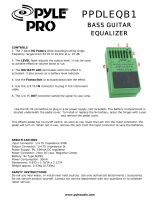
16
4.1 The Fat Channel
Overview ControlsHookup ResourcesGetting Started Digital Effects
Master Control
Troubleshooting
and Warranty
Controls
High Pass Filter On/Off. Turns
the High Pass Filter On/Off for the
Selected Channel or Output Bus.
This button engages and
disengages the high-pass filter
for the selected channel or
output bus. It will illuminate
to indicate that the high-pass
filter has been enabled.
The high-pass filter is available
on the 16 channels of the
input bus, the 4 aux buses,
and both internal FX buses.
High Pass Filter Frequency.
Adjusts the High Pass Filter’s
Cutoff Frequency.
The High Pass Filter section
consists of an encoder and
a meter. Frequency range is
indicated to the left of the
meter. The filter’s threshold can
be set from 24 Hz to 1 kHz.
The High Pass Filter’s
slope is -6 dB/octave.
Power User Tip: A high-pass filter
attenuates all frequencies below
the set threshold. Use the Fat
Channel High Pass Filter to remove
unwanted low-frequencies from
your source signal, rather than
trying to EQ them out.
Gate On/Off Button.
Turns the Gate On/Off for the
Selected Channel.
This button engages and
disengages the gate for
the selected channel. It will
illuminate to indicate that
the gate has been enabled.
The gate is available for all
input and output buses.
Power User Tip: The “Gate” in
your StudioLive 16.0.2 is actually
a downward expander. In
contrast to compression, which
decreases the level of a signal after
it rises above the compression
threshold, expansion decreases
the level of a signal after the
signal goes below the expansion
threshold. Commonly used
for noise reduction, the major
difference between expansion
and noise gating is that expansion
is dependent on the signal
level after the level crosses the
threshold, whereas a noise gate
works independent of a signal’s
level beyond the threshold.
Gate Threshold. Sets and
Displays the Threshold of the
Gate for the Selected Channel.
This encoder sets, and the meter
displays, the gate threshold
for the selected channel. The
threshold determines the level
at which the gate will open.
Essentially, all signals above the
threshold setting are passed
through unaffected. You can set
the threshold from 0 to -56 dB.
Power User Tip: If the threshold
is set fully counterclockwise,
the gate is turned off (always
open), allowing all signals to
pass through unaffected.
Compressor On/Off. Turns the
Compressor On/Off for the
Selected Channel or Output Bus.
This button engages or
disengages the compressor
for the selected channel or
output bus. It will illuminate to
indicate that the compressor
has been enabled.
The compressor is available for
all input and output buses.
Power User Tip: A compressor is
a type of amplifier in which gain
is dependent on the signal level
passing through it. You can set
the maximum level a compressor
allows to pass through, thereby
causing automatic gain reduction
above some predetermined signal
level, or threshold. Compression
refers, basically, to the ability
to reduce, by a fixed ratio, the
amount by which a signal’s
output level can increase relative
to the input level. It is useful for
lowering the dynamic range of
an instrument or vocal, making it
easier to record without distorting
the recorder. It also assists in the
mixing process by reducing the
amount of level changes needed
for a particular instrument.






















